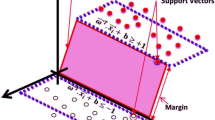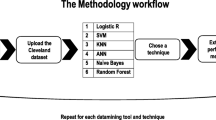Abstract
In telemedicine-based healthcare system, such as cardiac health monitoring system, large amount of data needs to be stored and transferred. This requires stupendous bandwidth and affects the channel efficiency. The main objective is to develop an efficient compression technique for solving such problems in healthcare systems. In this work, the coalition of empirical mode decomposition (EMD) and tunable quality wavelet transform (TQWT) scheme has been proposed for ECG signal compression with a suitable decomposition level. Thus, the maximum energy is packed for fewer coefficients which have a significant contribution to the original signal. The dynamic thresholding and dead-zone quantization are evaluated, to discard the wavelet coefficients with a small value near zero. Subsequently, a run-length encoding (RLE) lossless compression scheme is employed to encode the wavelet coefficients. The presented technique was evaluated on the Massachusetts Institute of Technology-Beth Israel Hospital (MITDB) arrhythmias dataset which contain regular and irregular heart rhythm. The compression ratio (CR%), percent root-mean-square error (PRD%), normalized PRD (NPRD%), quality score (QS), and signal-to-noise ratio (SNR) of 33.11, 4.35, 8.21, 7.59, and 51.09 have been achieved, after implementing on 48 ECG records with 30-min duration. The presented method was also implemented for normal and abnormal heartbeat classification for validation. The random forest algorithm (RFA) is employed for the classification of cardiac rhythm. The results show minimal distortion with an improved reconstruction of a signal after the compression and show a better performance than the state-of-art technique.













Similar content being viewed by others
Availability of data and materials
We have used publicly available standard database which are available on https://archive.physionet.org/cgi-bin/atm/ATM.
References
World Health Statistics 2013, World Health Org., Geneva, Switzerland (2013)
Tsai, T.-H., Kuo, W.-T.: An efficient ECG lossless compression system for embedded platforms with telemedicine applications. IEEE Access 6, 42207–42215 (2018)
Sugano, H.. et al.: Continuous ECG data gathering by a wireless vital sensor—evaluation of its sensing and transmission capabilities. In: Proc. IEEE ISSSRA, Taichung, Taiwan, pp. 98–102 (2010)
Singh, B., Kaur, A., Singh, J.: A review of ECG data compression techniques. Int. J. Comput. Appl. 116(11), 39–44 (2015)
Wang, F., Ma, Q., Liu, W., Chang, S., Wang, H., He, J., Huang, Q.: A novel ECG signal compression method using spindle convolutional auto-encoder. Comput. Methods Programs Biomed. 175, 139–150 (2019)
Singhai, P., Kumar, A., Ateek, A., Ansari, I.A., Singh, G.K., Lee, H.N.: ECG signal compression based on optimization of wavelet parameters and threshold levels using evolutionary techniques. Circuits Syst. Signal Process. 1–29 (2023)
Kolekar, M.H., Jha, C.K., Kumar, P.: ECG data compression using modified run length encoding of wavelet coefficients for holter monitoring. IRBM 43(5), 325–332 (2022)
Mueller, W.C.: Arrhythmia detection program for an ambulatory ECG monitor. Biomed. Sci. Instrum. 14, 81–85 (1978)
Furht, B., Perez, A.: An adaptive real-time ECG compression algorithm with variable threshold. IEEE Trans. Biomed. Eng. 35(6), 489–494 (1988)
Abenstein, J.P.: Algorithms for real-time ambulatory ECG monitoring. Biomed. Sci. Instrum. 14, 73–79 (1978)
Fira, C.M.: An ECG signals compression method and its validation using NNs. IEEE Trans. Biomed. Eng. 55, 1319–1326 (2008)
Cohen, A., Poluta, M., Scott-Millar, R.: Compression of ECG signals using vector quantization. In: South African sympos on comm and signal processing, pp. 49–54 (1990)
Akazawa, K.: Adaptive data compression of ambulatory ECG using multi templates. In: IEEE Proc. of Comput. in Cardiol Conference, pp. 495–498 (1993)
Deepu, C.J., Lian, Y.: A joint QRS detection and data compression scheme for wearable sensors. IEEE Trans. Biomed. Eng. 62, 165–175 (2015). https://doi.org/10.1109/TBME.2014.2342879
Aydin, M.C., Enis Çetin, A., Köymen, H.: ECG data compression by sub-band coding. Electron. Lett. 27(4), 359–360 (1991)
Chandra, S., Sharma, A., Singh, G.: Computationally efficient cosine modulated filter bank design for ECG signal compression. IRBM 41(1), 2–17 (2020)
Ma, J., Zhang, T., Dong, M.: A novel ECG data compression method using adaptive Fourier decomposition with security guarantee in e-health applications. IEEE J. Biomed. Health Inform. 19(3), 986–994 (2015)
Cetin, A.E., Koymen, H., Cegiz Aydin, M.: Multichannel ECG data compression by multirate signal processing and transform domain coding techniques. IEEE Trans. Biomed. Eng. 40(5), 495–499 (1993)
Jha, C.K., Kolekar, M.H.: Tunable Q-wavelet based ECG data compression with validation using cardiac arrhythmia patterns. Biomed. Signal Process. Control 66, 102464 (2021)
Ziran, P.: Research and improvement of ECG compression algorithm based on EZW. Comput. Meth. Prog. Bio. 145, 157–166 (2017)
Cetin, A.E., Tewfik, A.H., Yardimci, Y.: Coding of ECG signals by wavelet transform extrema. In: Proceedings of IEEE-SP International Symposium on Time-Frequency and Time-Scale Analysis, pp. 544–547. IEEE (1994)
Wang, X., Chen, Z., Luo, J., Meng, J., Xu, Y.: ECG compression based on combining of EMD and wavelet transform. Electron. Lett. 52(19), 1588–1590 (2016)
Zhao, C., Chen, Z., Meng, J., Xiang, X.: Electrocardiograph compression based on sifting process of empirical mode decomposition. Electron. Lett. 52(9), 688–690 (2016)
Selesnick, I.W.: Wavelet transform with tunable Q-factor. IEEE Trans. Signal Process. 59(8), 3560–3575 (2011)
Pal, H.S., Kumar, A., Vishwakarma, A., Ahirwal, M.K.: Electrocardiogram signal compression using tunable-Q wavelet transform and meta-heuristic optimization techniques. Biomed. Signal Process. Control 78(2022), 103932 (2022)
Patidar, S., Pachori, R.B.: Tunable-q wavelet transform based optimal compression of cardiac sound signals. In: 2016 IEEE Region 10 Conference, TENCON, pp. 2193–2197. IEEE (2016)
Patidar, S., Pachori, R.B.: Classification of cardiac sound signals using constrained tunable-q wavelet transform. Expert Syst. Appl. 41(16), 7161–7170 (2014)
Patidar, S., Pachori, R.B.: Segmentation of cardiac sound signals by removing murmurs using constrained tunable-q wavelet transform. Biomed. Signal Process. Control 8(6), 559–567 (2013)
Patidar, S., Pachori, R.B., Garg, N.: Automatic diagnosis of septal defects based on tunable-q wavelet transform of cardiac sound signals. Expert Syst. Appl. 42(7), 3315–3326 (2015)
Sharma, N., Sunkaria, R.K., Sharma, L.D.: QRS complex detection using stationary wavelet transform and adaptive thresholding. Biom. Phys. Eng. Express 8(6), 065011 (2022)
Cetin, A.E., Köymen, H.: Compression of digital biomedical signals. In: The Biomedical Engineering Handbook: Medical Devices and Systems, pp. 3–1. CRC Press (2006)
Chen, J., Wang, F., Zhang, Y., Shi, X.: ECG compression using uniform scalar dead-zone quantization and conditional entropy coding. Med. Eng. Phys. 30(4), 523–530 (2008)
Jha, C.K., Kolekar, M.H.: Empirical mode decomposition and wavelet transform based ECG data compression scheme. IRBM 42(1), 65–72 (2021)
Abdalla, F.Y., Wu, L., Ullah, H., Ren, G., Noor, A., Zhao, Y.: ECG arrhythmia classification using artificial intelligence and nonlinear and nonstationary decomposition. Signal Image Video Process 13, 1283–1291 (2019)
Cox, J.R., Nolle, F.M., Fozzard, H.A., Oliver, G.C.: AZTEC, a preprocessing program for real-time ECG rhythm analysis. IEEE Trans. Biomed. Eng. 2, 128–129 (1968)
Jha, C.K., Kolekar, M.K.H.: ECG data compression algorithm for telemonitoring of cardiac patients. Int. J. Telemed. Clin. Pract. 2(1), 31–41 (2017)
Ahmed, S.M., Al-Ajlouni, A.F., Abo-Zahhad, M., Harb, B.: ECG signal compression using combined modified discrete cosine and discrete wavelet transform. J. Med. Eng. Technol. 33(1), 1–8 (2009)
Kumar, R., Kumar, A., Pandey, R.K.: Beta wavelet-based ECG signal compression using lossless encoding with modified thresholding. Comput. Electr. Eng. 39(1), 130–140 (2013)
Jha, C.K., Kolekar, M.H.: Diagnostic quality assured ECG signal compression with a selection of appropriate mother wavelet for minimal distortion. IET Sci. Meas. Technol. 13(4), 500–508 (2019)
Mohebbian, M.R., Wahid, K.A.: ECG compression using optimized B-spline. Multimed. Tools Appl. 1–13 (2023)
Pan, J., Tompkins, W.J.: A real-time QRS detection algorithm. IEEE Trans. Biomed. Eng. 32(3), 230–236 (1985)
Acknowledgements
The authors are thankful to the Biomedical Signal and Image Processing Group of Dr. B R Ambedkar National Institute of Technology, Jalandhar, for their interest in this work and useful comments to draft the final form of this paper. The authors greatly acknowledge the support of SERB-DST, the Government of India, sponsored Research Project sanctioned vide File No. EEQ/2018/000925) Dated: 22 March 2019 to carry out this present work. We would like to thank Dr. B R Ambedkar National Institute of Technology, Jalandhar, for the laboratory facilities and research environment to carry out this work.
Funding
This work has been supported by: SERB-DST, Government of India, and Ministry of Education, Government of India, at National Institute of Technology, Jalandhar.
Author information
Authors and Affiliations
Contributions
NS and RKS contributed to the design and implementation of the research, to the analysis of the results, and to the writing of the manuscript.
Corresponding author
Ethics declarations
Conflict of interests
The authors declare that they have no conflict of interest.
Ethical approval
We have used publicly available standard databases in our experiment. Therefore, we do not need any ethical consent for this study.
Additional information
Publisher's Note
Springer Nature remains neutral with regard to jurisdictional claims in published maps and institutional affiliations.
Rights and permissions
Springer Nature or its licensor (e.g. a society or other partner) holds exclusive rights to this article under a publishing agreement with the author(s) or other rightsholder(s); author self-archiving of the accepted manuscript version of this article is solely governed by the terms of such publishing agreement and applicable law.
About this article
Cite this article
Sharma, N., Sunkaria, R.K. ECG compression based on empirical mode decomposition and tunable-Q wavelet transform with validation using heartbeat classification. SIViP 18, 3079–3095 (2024). https://doi.org/10.1007/s11760-023-02972-7
Received:
Revised:
Accepted:
Published:
Issue Date:
DOI: https://doi.org/10.1007/s11760-023-02972-7




